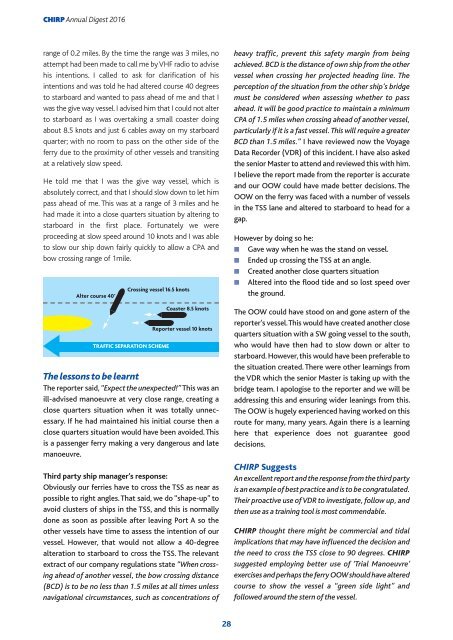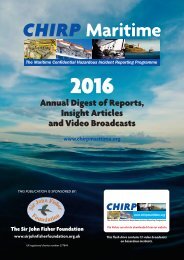CHIRP annual digest 2016 6th
Create successful ePaper yourself
Turn your PDF publications into a flip-book with our unique Google optimized e-Paper software.
<strong>CHIRP</strong> Annual Digest <strong>2016</strong><br />
range of 0.2 miles. By the time the range was 3 miles, no<br />
attempt had been made to call me by VHF radio to advise<br />
his intentions. I called to ask for clarification of his<br />
intentions and was told he had altered course 40 degrees<br />
to starboard and wanted to pass ahead of me and that I<br />
was the give way vessel. I advised him that I could not alter<br />
to starboard as I was overtaking a small coaster doing<br />
about 8.5 knots and just 6 cables away on my starboard<br />
quarter; with no room to pass on the other side of the<br />
ferry due to the proximity of other vessels and transiting<br />
at a relatively slow speed.<br />
He told me that I was the give way vessel, which is<br />
absolutely correct, and that I should slow down to let him<br />
pass ahead of me. This was at a range of 3 miles and he<br />
had made it into a close quarters situation by altering to<br />
starboard in the first place. Fortunately we were<br />
proceeding at slow speed around 10 knots and I was able<br />
to slow our ship down fairly quickly to allow a CPA and<br />
bow crossing range of 1mile.<br />
Alter course 40°<br />
Crossing vessel 16.5 knots<br />
TRAFFIC SEPARATION SCHEME<br />
Coaster 8.5 knots<br />
Reporter vessel 10 knots<br />
The lessons to be learnt<br />
The reporter said, “Expect the unexpected!” This was an<br />
ill-advised manoeuvre at very close range, creating a<br />
close quarters situation when it was totally unnec -<br />
essary. If he had maintained his initial course then a<br />
close quarters situation would have been avoided. This<br />
is a passenger ferry making a very dangerous and late<br />
manoeuvre.<br />
Third party ship manager’s response:<br />
Obviously our ferries have to cross the TSS as near as<br />
possible to right angles. That said, we do “shape-up” to<br />
avoid clusters of ships in the TSS, and this is normally<br />
done as soon as possible after leaving Port A so the<br />
other vessels have time to assess the intention of our<br />
vessel. However, that would not allow a 40-degree<br />
alteration to starboard to cross the TSS. The relevant<br />
extract of our company regulations state “When cross -<br />
ing ahead of another vessel, the bow crossing distance<br />
(BCD) is to be no less than 1.5 miles at all times unless<br />
navigational circumstances, such as concentrations of<br />
heavy traffic, prevent this safety margin from being<br />
achieved. BCD is the distance of own ship from the other<br />
vessel when crossing her projected heading line. The<br />
perception of the situation from the other ship’s bridge<br />
must be considered when assessing whether to pass<br />
ahead. It will be good practice to maintain a minimum<br />
CPA of 1.5 miles when crossing ahead of another vessel,<br />
particularly if it is a fast vessel. This will require a greater<br />
BCD than 1.5 miles.” I have reviewed now the Voyage<br />
Data Recorder (VDR) of this incident. I have also asked<br />
the senior Master to attend and reviewed this with him.<br />
I believe the report made from the reporter is accurate<br />
and our OOW could have made better decisions. The<br />
OOW on the ferry was faced with a number of vessels<br />
in the TSS lane and altered to starboard to head for a<br />
gap.<br />
However by doing so he:<br />
■ Gave way when he was the stand on vessel.<br />
■ Ended up crossing the TSS at an angle.<br />
■ Created another close quarters situation<br />
■ Altered into the flood tide and so lost speed over<br />
the ground.<br />
The OOW could have stood on and gone astern of the<br />
reporter’s vessel. This would have created another close<br />
quarters situation with a SW going vessel to the south,<br />
who would have then had to slow down or alter to<br />
starboard. However, this would have been preferable to<br />
the situation created. There were other learnings from<br />
the VDR which the senior Master is taking up with the<br />
bridge team. I apologise to the reporter and we will be<br />
addressing this and ensuring wider leanings from this.<br />
The OOW is hugely experienced having worked on this<br />
route for many, many years. Again there is a learning<br />
here that experience does not guarantee good<br />
decisions.<br />
<strong>CHIRP</strong> Suggests<br />
An excellent report and the response from the third party<br />
is an example of best practice and is to be congratulated.<br />
Their proactive use of VDR to investigate, follow up, and<br />
then use as a training tool is most commendable.<br />
<strong>CHIRP</strong> thought there might be commercial and tidal<br />
implications that may have influenced the decision and<br />
the need to cross the TSS close to 90 degrees. <strong>CHIRP</strong><br />
suggested employing better use of ‘Trial Manoeuvre’<br />
exercises and perhaps the ferry OOW should have altered<br />
course to show the vessel a “green side light” and<br />
followed around the stern of the vessel.<br />
28



